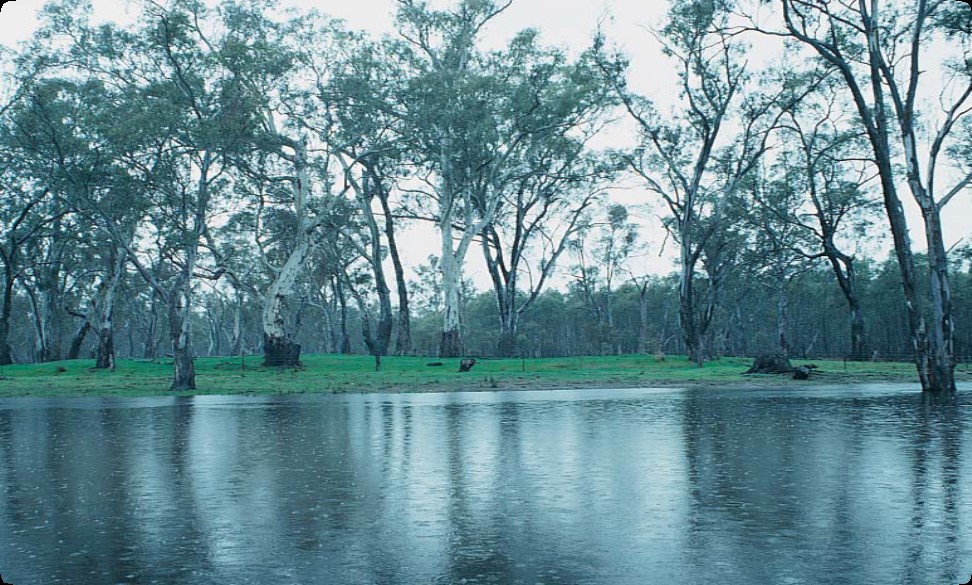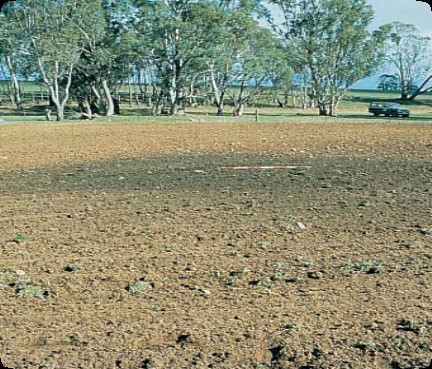Characteristics
- circular or oval shape
- often less than 50 cm high and 10 m wide, though sometimes much larger
- dark (often black) and sometimes greasy sediment
- lumps of burnt clay or stone and small fragments of charcoal often present
- shells, animal bones, stone tools and Ancestral Remains sometimes present
- rabbit burrows present
In land which has been extensively ploughed the site of a mound will appear as an area of dark stained earth. If you look closely, you may find charcoal fragments, burnt clay lumps and hearth stones.
What are Aboriginal mounds?
Aboriginal mounds are places where Aboriginal people lived over long periods of time. Mounds often contain charcoal, burnt clay or stone heat retainers from cooking ovens, animal bones, shells, stone tools and, sometimes, Aboriginal burials.
Where are they found?
Usually near rivers, lakes or swamps but occasionally some distance from water. Mounds often occur on floodplains and the banks of watercourses.
They are also found on dunes and sometimes among rock outcrops on higher ground.
What produced Aboriginal mounds?
Aboriginal people often cooked their food in earth ovens. To do this, they heated stones or burnt clay lumps and placed them in a pit. The food - a kangaroo or tubers for example - was placed on top of the heat retainers and the pit was filled in.
Once the food was cooked, it was removed, and all the cooking debris, such as stone, clay and ash, was swept out. Over time, the debris from cooking and other domestic activities combined with natural sediments to form a mound.
Aboriginal people usually built shelters or huts from bark or wood. Heaped earth was sometimes used as a foundation, or to strengthen and insulate the walls of these structures.
Fires were frequently built in front of, or near, the shelters. Artefacts such as stone tools were often made close by. It is likely that the debris produced by these activities, as well as the wood and bark from the eventual collapse of the shelters, helped the build up of mounds.
How else can mounds be formed?
Mounds created by Europeans in more recent times can be mistaken for Aboriginal mounds. In particular, the common farming practice of piling and burning tree stumps is likely to produce a mound which contains burnt clay, burnt stone and charcoal.
Europeans also burnt timber to make charcoal for use in metal smelting. Mounds resulting from this practice usually contain large quantities of charcoal, often in large chunks. Neither of these types of mound contain stone tools, shells or animal bones.
Mounds can also form naturally. Low rises can occur where a clay ground surface has cracked and swollen. Hummocks occur where sand has been trapped by vegetation. Mounds may form near rivers and creeks where sediment is washed up over tree branches or small shrubs.
These mounds will not contain burnt materials, and will usually not contain stone tools, shells or animal bones.
Why are Aboriginal mounds important?
Mounds provide valuable information about past Aboriginal settlement and lifestyles. Most known mound sites are less than 3000 years old.
The relatively common occurrence of mounds in some parts of Victoria (particularly the Western District and Murray Valley) after this date, may represent a change in the way Aboriginal people in these areas cooked and made camp.
Mounds provide Aboriginal people today with an important link to their culture and their past. Mounds which contain Aboriginal burials are particularly significant.
Threats to Aboriginal mounds
The loose, soft soil often found in mounds attracts burrowing animals, particularly rabbits, which severely disturb these sites. Ripping of rabbit warrens, as well as ploughing and laser levelling of agricultural land, has destroyed many mounds.
First Peoples - State Relations records the location, dimensions, and condition of Aboriginal mounds so that we will have a permanent record of this important part of the heritage of all Australians. Management works, such as the eradication of rabbits and erosion control, are carried out so that Aboriginal mounds can be preserved for future generations.
Are Aboriginal mounds protected?
All Aboriginal cultural places in Victoria are protected by law. Aboriginal artefacts are also protected.
It is against the law to disturb or destroy an Aboriginal place. Artefacts should not be removed from site.
What to do if you find a mound
Check whether the mound has the typical characteristics of an Aboriginal mound. If it does, record its location and write a brief description of its condition. Note whether it is under threat of disturbance.
Please help to preserve Aboriginal cultural places by reporting their presence to First Peoples - State Relations.
Updated



